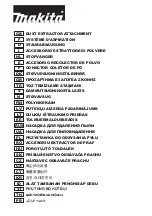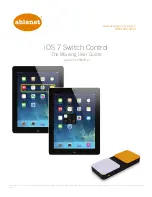
P/N 112355 rev. A
7
WORLD-BEAM
®
QS30 Series –
Polarized Retroreflective Laser Sensors
Banner Engineering Corp.
•
Minneapolis, MN U.S.A.
www.bannerengineering.com • Tel: 763.544.3164
Installation Notes
Conventional retroreflective photoelectric sensors are extremely easy to align. Beam
angles are wide, and retro targets are forgiving to the light beam’s angle of incidence.
The beam of this laser sensor is very narrow, compared with the beam of most retro
sensors. As Figure 6 indicates, the effect of angular misalignment can be dramatic.
Alignment is critical because the beam may miss the retroreflective target unless the
target is large.
For example, with one BRT-36X40BM mounted at a distance of 6 m (20') from the
sensor, one degree of angular misalignment will cause the center of the laser beam to
miss the center of the target by 100 mm (4").
Alignment Tip
When using a small retroreflective target at medium or long range, it is often useful
to temporarily attach (or suspend) a strip of retroreflective tape (e.g., BRT-TVHG-2X2)
along a line that intersects the actual target. The visible red laser beam is easily seen
in normal room lighting on such tape. Sight along the beam toward the target (from
behind the sensor). Move the sensor to scan the laser beam back and forth across the
retro tape strip. Use the tape strip to guide the beam onto the target.
Consider using sensor mounting bracket model SMB30SC (see page 11). This swivel
bracket can simplify multiple-axis alignment. Alignment is complete when the visible
image is centered on the retro target. The perpendicularity of the laser beam to the face
of the retro target is forgiving, just as it is with a conventional retroreflective sensor.
Effective Beam Size
Unlike conventional retroreflective sensors, the retroreflective laser has the ability to
sense relatively small profiles. Figure 7 indicates the diameter of the smallest opaque
rod which will reliably break the laser beam at several sensor-to-object distances using
sensor model QS30LLP(Q). These minimum object sizes were measured with the
sensor aligned to a BRT-36X40 reflector and the gain set to maximum using the Max
Excess Gain SET. This sensor is typically recommended for long-range applications of
relatively small targets that will completely break the beam.
Smaller objects can be detected by using model QS30LLPC(Q), adjusting the sensor
gain down using the Manual Adjust, or performing a Low-Contrast SET of the reflector.
Objects as small as 2.0 mm can be reliably detected after performing the Low-Contrast
SET at ranges up to 6 m (18'). This sensor is typically recommended for shorter-range
applications detecting very small targets that may break only a portion of the beam.
Note that the shape of the beam is elliptical. The minimum object sizes listed assume
passage of the rod across the major diameter of the ellipse (worst case). It may be
possible to detect objects smaller than the sizes listed if the direction in which the
objects pass through the beam can be controlled.
Retroreflector Recommendations
• BRT-36X40BM recommended for beam-block applications up to 18 m range.
• BRT-TVHG-2X2 recommended for applications up to 2 m range. (This retroreflector is
an adhesive-backed sealed tape with micro-prism geometry.)
Sensing Distance = X
Ø = Misalignment Angle
Y = X(tan Ø)
Y
Sensor-to-
Target
Distance (X)
Beam Displacement
(Y) for 1° of
Misalignment
1.5 m (5')
25 mm (1")
3 m (10')
50 mm (2")
6 m (20')
100 mm (4")
15 m (50')
250 mm (10")
30 m (100')
500 mm (20")
Figure 6. Beam displacement per degree of
misalignment
Figure 7. Minimum object detection size
vs. distance from sensor, model
QS30LLP(Q)
Sensor-to-
Object
Distance (X)
Minimum Object
Detection Size
0.3 m (1')
2.5 mm (0.10")
1.5 m (5')
5.0 mm (0.20")
3 m (10')
7.0 mm (0.28")
18 m (59')
13 mm (0.52")
CAUTION ...
Never stare directly into
the sensor lens.
Laser light
can damage your eyes. Avoid placing
any mirror-like object in the beam.
Never use a mirror as a retroreflective
target.
!






























